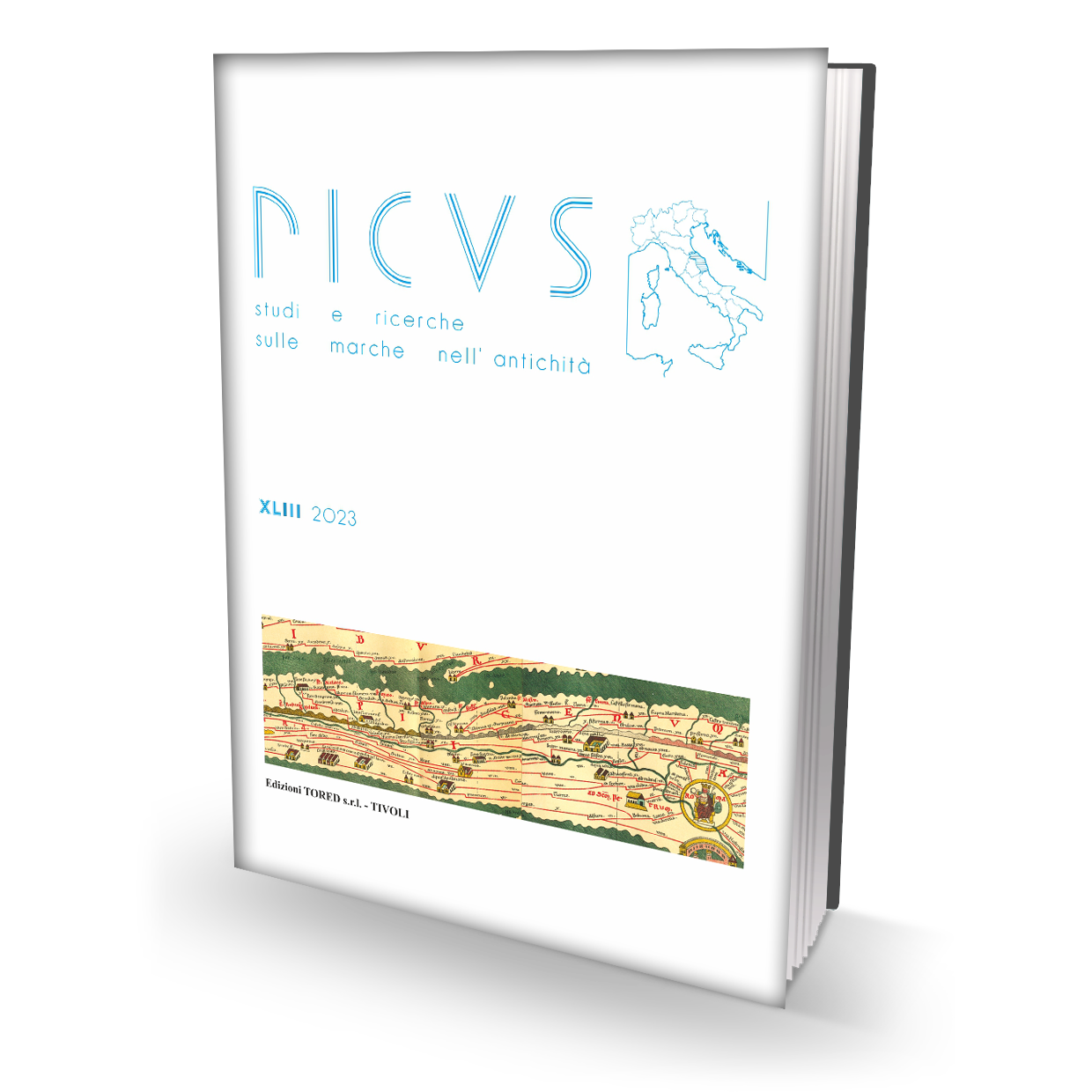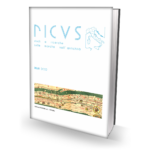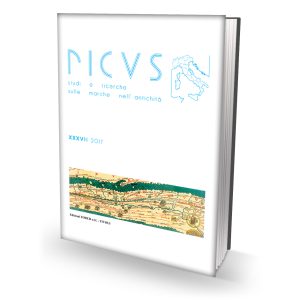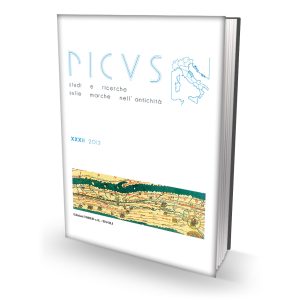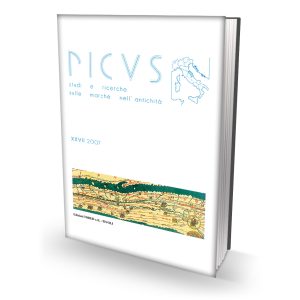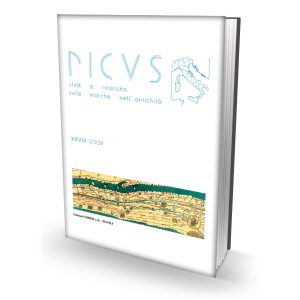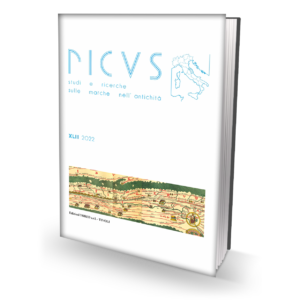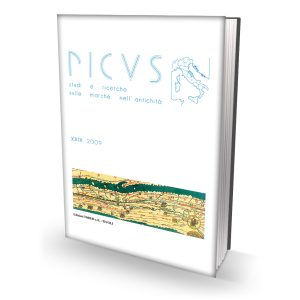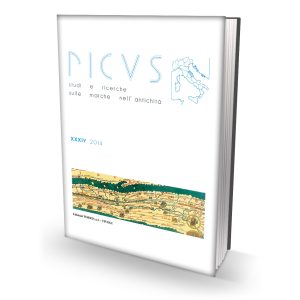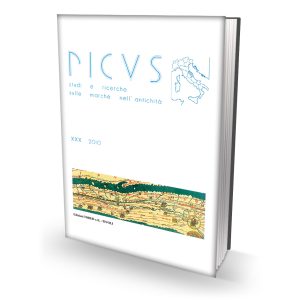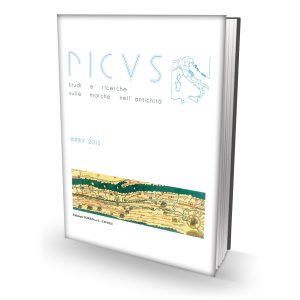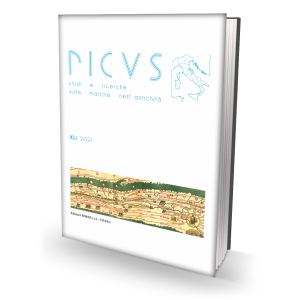PICUS XLIII – 2023. STUDI E RICERCHE SULLE MARCHE NELL’ANTICHITÀ
70,00 €
Anno Edizione: 2023
Formato 17×24 – Pagine 320
Confezione a filo refe con copertina 4 colori
ISSN 0394-3968 – ISBN 9788899846879
Prezzo: € 70,00
- Descrizione
- ABSTRACTS
Descrizione
Indice del Volume
Saggi e articoli
M. Buonocore, Per la tradizione manoscritta dell’epigrafia di Auximum e Ricina: nuove testimonianze
C. Franceschelli, Archeologia e mobilità urbana in età romana: due casi di studio nelle Marche
N. Lucentini, Le tribolazioni di un archeologo: Edoardo Brizio a Montefortino
S.M. Marengo, Argenti nella necropoli ellenistica di Ancona: le iscrizioni ponderali
N. Negroni Catacchio – V. Gallo, Le ambre figurate picene, una rivisitazione
G. Paci, Due importanti epigrafi anconetane dalla storia tormentata
F. Pesando – M. Giglio – S. Antolini – M. Capurro – D. Garzillo – C. Mattei, Ritorno a Cupra. Scavi stratigrafici nel tempio del foro e nuovi dati sulla messa in opera dell’opus reticulatum nel I sec. d.C.
Schede e notizie
R. Cordella – N. Criniti, Frammento di epigrafe funeraria da Piano Ristéccio (Civitella del Tronto, TE)
Bibliografia
Recensioni:
F. Belfiori, Mare Superum. Romani, Latini e l’Italia adriatica di mezzo (sviluppi culturali e fenomenologia religiosa, secoli III-I a.C.), Roma – Bristol 2022 (Ch. Delplace)
A. Bertrand – T. Capriotti, Regio V: Ancona, Cingoli, Cupra Montana, Numana, Osimo, San Vittore di Cingoli, Roma 2021 (= ‘Fana Templa delubra’ 7) (G. Paci)
E. Giorgi – F. Demma – F. Belfiori, Il santuario di Monte Rinaldo. La ripresa delle ricerche (2016-2019), Bologna 2020 (V. Belfiore)
Schede per località:
Pergola (PU) (M. Cruciani)
Segnalazioni:
a cura di F. Cancrini – G. Paci – M. Pasqualini
Saggi e articoli
M. Buonocore, Per la tradizione manoscritta dell’epigrafia di Auximum e Ricina: nuove testimonianze, p. 9-38
Two of the Inscriptiones sacrosanctae vetustatis of Apianus in the Vatican Library contribute to the manuscript tradition of the epigraphy of Auximum and Ricina. The Stamp. R.G. Arte Arch. II. 532 is integrated by an anonymous scriptor, the Stamp. R.G. Arte Arch. II. 1192 was annotated by its owner Angelo Androzi from Montecchio before passing in the library of Pompeo Compagnoni. The document shows the epigraphical and antiquarian interests of this erudite jurisconsult.
C. Franceschelli, Archeologia e mobilità urbana in età romana: due casi di studio nelle Marche, p. 39-74
The urban traffic problems were not unknown in Roman times. Several ancient authors, among which Martial and Juvenal, complained about the discomfort caused by the transit of heavy vehicles through the streets of Rome, and more than one emperor tried to prevent or limit the presence of vehicles in the city.
In recent years, archaeology has made it possible to investigate this issue, especially through the analysis of the wheel ruts left on the road pavements by the continuous passage of chariots. This article fits into this tradition of studies and aims at developing the topic of traffic management within two urban centres in the Marche region: Pesaro and Ostra. This goes through the implementation of traffic management devices, aimed for example at defining oneway
streets or banning heavy vehicles from passing through some streets of the urban area.
Another aspect of vehicular traffic management, attested by archaeological sources and particularly clear in the case of Ostra, is the definition of ‘bypass’ road systems, which allowed a rapid traffic flow to those travellers who did not wish to stop in the city. Instead, for those who had to or wanted to stop, accommodation facilities were set up at the entrance to the town, where travellers could leave their vehicles and travel to the town on foot or by light vehicles.
N. Lucentini, Le tribolazioni di un archeologo: Edoardo Brizio a Montefortino, p. 75-111
The revision of archival documents for a critical edition of the Celtic necropolis of Montefortino d’Arcevia ( AN, Italy), excavated in the years 1894-1899, has returned sketches, drawings, floorplans and annotations that document several inconsistencies in the original 1901 edition and the intersection of personalities and characters and the material circumstances that determined them.
S.M. Marengo, Argenti nella necropoli ellenistica di Ancona: le iscrizioni ponderali, p. 113-128
Publication of the inscribed silver objects from the Hellenistic necropolis of Ancona. They are 2nd – 1st inscriptions marking the property and the weight of the objects in Greek and Latin. The ponderal system uses litrae, drachmae, unciae and their submultiples as units.
N. Negroni Catacchio – V. Gallo, Le ambre figurate picene, una rivisitazione, p. 129-158
During the Iron Age Picenum becomes one of the Italian regions with the highest concentration of amber artefacts: there are beads, pendants, spacer-beads, buttons, earrings’ elements, big rings, fibulas’ elements, cloak pin’s coating, inlays and bezel. Among these, there are also figured exemplars, which do not represent a simple geometric shape, but anthropomorphic and zoomorphic subjects, with a few cases of representations of complex scenes with more than one characters.
Carved ambers in Picenum chronologically focus during the 6th century BC, with some older artefacts dated to 8th and 7th century BC. They were discovered in funerary contexts from Numana, Sirolo, Ancona, Pianello di Castelbellino, Matelica, Pitino di San Severino, Recanati, Montegiorgio and Belmonte Piceno. Among the represented characters we can find women’s and rams’ heads, birds, little human masks, felines, human figures, bullae enriched by complex representations and cowries. Other types are sporadic, such as the crouching monkey and the representation of anatomic parts. There are also some carved ambers, currently stored in foreign museums,which are said to be from the Picenum (from Falconara and Ascoli Piceno territory). Based on the stylistic analysis, we could speculate a similar geographic collocation for other exemplars too.
This paper aims to offer an overview, as updated as possible, of carved ambers from Picenum and to include the discoveries in the frame of contacts with the Etruscan world, Magna Graecia and eastern Adriatic side.
G. Paci, Due importanti epigrafi anconetane dalla storia tormentata, p. 159-188
L’inscription d’un militaire de carrière, par la suite fonctionnaire ayant la charge de combattre le banditisme dans les régions de l’Adriatique central et des Pouilles, a disparu sous les bombardements qui ont touché Ancône en 1943 et 1944: les fragments qui auraient éventuellement survécu sont actuellement introuvables. La récupération d’une photo d’archive a permis d’en fournir une édition mise à jour et d’en revoir les différentes problématiques historiques. Le second cas concerne une inscription paléo-chrétienne réutilisée sous la base d’une colonne de la cathédrale de Saint-Cyriaque à Ancône, qui aurait été dégagée, mais reste toujours inaccessible. Grâce à quelques photos, il a été possible d’en restituer le texte, permettant ainsi d’en dépasser les difficultés d’interprétation précédentes.
F. Pesando – M. Giglio – S. Antolini – M. Capurro – D. Garzillo – C. Mattei, Ritorno a Cupra. Scavi stratigrafici nel tempio del foro e nuovi dati sulla messa in opera dell’opus reticulatum nel I sec. d.C., p. 189-262
The study takes up the building history of the large temple facing the west side of the Forum after new investigations in 2022; the building had so far been only partially brought to light by previous excavations. The high–podiumed temple, of Corinthian order and provided with a deep cella, was built in the Augustan age and was thoroughly renovated from the foundations in a second phase, following a series of structural injuries that had endangered the entire building. On that occasion the cell’s splendid pictorial decoration, belonging to the so-called. III Pompeian style, was buried in the deep filling of the podium, the foundations were reinforced and the entire wall of the cella rebuilt in brickwork; of the latter it was possible to bring to light in collapse almost the entire north side. Among the architectural elements recovered from the excavation are fragments of columns and some good-quality lion’s head stone dripstones, also dating from the reconstruction of the temple.
Schede e notizie
R. Cordella – N. Criniti, Frammento di epigrafe funeraria da Piano Ristéccio (Civitella del Tronto, TE), p. 265-269
The inscribed fragment may have belonged to a funerary monument of some importance. The area in which it is located has not provided other epigraphic evidence.
Bibliografia
Recensioni:
F. Belfiori, Mare Superum. Romani, Latini e l’Italia adriatica di mezzo (sviluppi culturali e fenomenologia religiosa, secoli III-I a.C.), Roma – Bristol 2022 (Ch. Delplace), p. 273-279
A. Bertrand – T. Capriotti, Regio V: Ancona, Cingoli, Cupra Montana, Numana, Osimo, San Vittore di Cingoli, Roma 2021 (= ‘Fana Templa delubra’ 7) (G. Paci), p. 280-285
E. Giorgi – F. Demma – F. Belfiori, Il santuario di Monte Rinaldo. La ripresa delle ricerche (2016-2019), Bologna 2020 (V. Belfiore), p. 285-292
Schede per località:
Pergola (PU) (M. Cruciani), p. 293-304
Segnalazioni:
a cura di F. Cancrini – G. Paci – M. Pasqualini, p. 313-318


